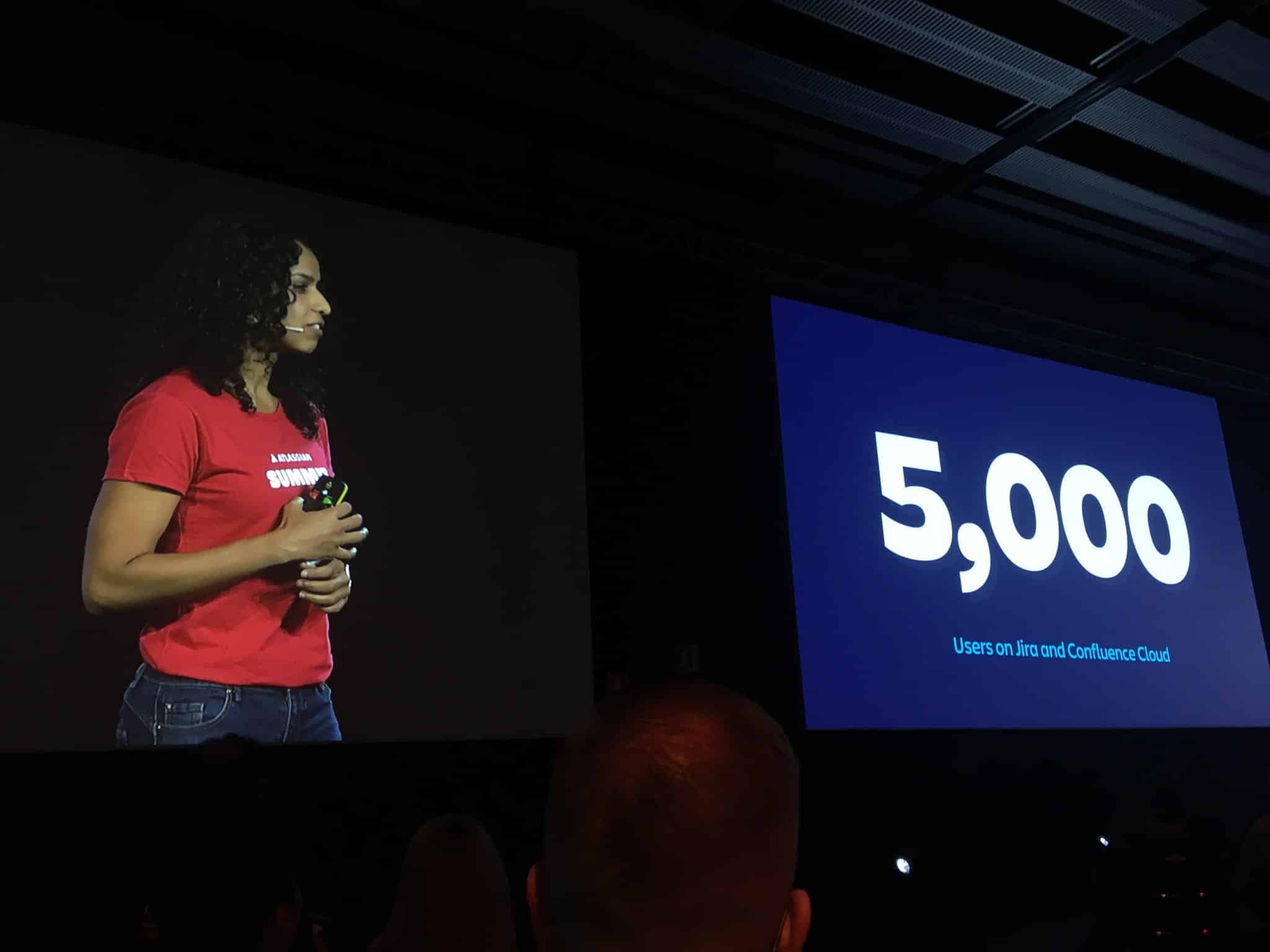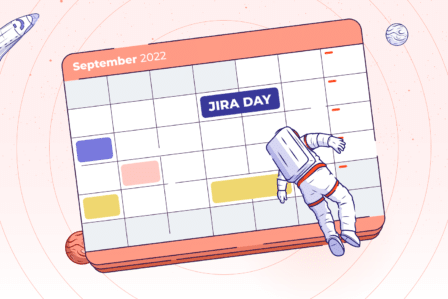The Fullest News Report from Atlassian Summit Europe 2018

The Atlassian Summit is the biggest annual live event dedicated to the worldwide user community of Atlassian software. We’re proud to have been sponsoring it for the third time in a row and debuting under the new Deviniti brand this year. During the recent event in Barcelona, plenty of new product launches and major updates were announced by Mike Cannon-Brookes, Scott Farquhar and Atlassian product managers. If you couldn’t make it to the event, or just want to have all the information in a single place, here’s the comprehensive report on these breaking news.
Atlassian’s stock price went up 44% within last 3 months with Slack and Jira Ops
The company’s value on the stock jumped up high in October 2017 after publishing their 2017Q1 revenue, which was better than expected and impressed the investors a lot. The Cloud development strategy enabled frictionless scaling and was giving its fruit through the next 3 quarters, resulting in 39% growth for the FY2018. But the truly amazing part of the story started at the end of July 2018, when Atlassian announced their partnership with Slack and thus discontinuation of their enterprise chat solutions, Stride and HipChat. The decision to step off the corporate chat market was perceived as a surrender by some part of the users, but it turned out a highly strategic decision for both companies:
- on one hand, conjunction with Atlassian allowed Slack to acquire new customers and stand their ground firmly against Microsoft Teams, Alphabet’s Google Hangouts Chat, and Facebook’s Workplace;
- on the other, getting out of Slack’s way released a big chunk of workforce for Atlassian to continue improving the existing product line, as well as take steps in another direction, somewhat more related to their area of expertise.
Modern software is developed more rapidly than ever, delivered over the Internet via SaaS or subscription and often hosted remotely. Such distribution models force developers to maintain and fix their products and the whole infrastructure as well, while overall IT downtime is estimated to cost businesses $700 billion per year in North America alone. Because of that, the IT operations software market has been growing during the last years and won’t stop any soon – it is even forecast to expand to $38 billion by 2022. So there’s not so much surprise that Atlassian turned to this direction.
One of the reasons we withdrew from the communications market is we see a much, much, much bigger prize for us in IT, said Scott Farquhar to The Australian Financial Review.
As the acquisition growth model proved effective last year with Trello, Atlassian purchased OpsGenie for $295 million, developed integrations with PagerDuty, xMatters, Slack, Statuspage and the Jira family, and packed them all into a single Jira-based incident management workflow called Jira Ops, which Scott announced last Tuesday at the Summit keynote. Here’s how it looks like.
So basically, with all these tools connected, Jira Ops covers each part of the process – from alerting the team, through real-time collaboration on fixing and notifying the customers on the progress, up to creating post-mortems and reporting. As Head of Software Teams Jens Schumacher stated, Atlassian has been building these tools for its internal teams over the years, and now the company is essentially turning its own playbook into a product. Being positioned as a ‘unified incident command center’, Jira Ops is meant to unite development teams who use Jira, Service Management-based support teams and operational staff using the other abovementioned tools as a standalone. This is a smart move by the Australian duo, by which they are going to compete with ServiceNow for a market share in the IT segment. The new product is now available for a beta early access program and will be released publicly in early 2019.
Somewhat unnoticed and pushed to the side by this big news, Atlassian partnered with InVision as well a couple of days before the Summit. Inspired by the Unleash the potential of every team motto, both enterprise software giant and the rising star of design and prototyping from Madison Avenue will now integrate their software even closer to enhance the connection between designers and developers. More details are to be announced soon, but even now it’s obvious that this partnership will strengthen InVision’s position against Sketch and Adobe in the cloud segment.
As a result of all these changes, Atlassian beat yet another stock record with almost $100 per share on NASDAQ, enjoying an $8 billion fiscal year. Mike Cannon-Brookes and Scott Farquhar placed 5th on the Australian richest people’s list with over $8.7 billion worth each.

Source: @JohnStensholt on Twitter
Update: on October 11, Atlassian has announced another partnership with Zoom, aiming to make video conference calls in Jira Service Management and Jira Ops possible.
We are very happy to share all these news as Platinum Solution Partners, as the Ecosystem grows along with Atlassian themselves. According to their CTO Sri Viswanath, Marketplace vendors note about 50% year-to-year growth as well, making a total of $500 million of lifetime revenue and $200 million from the last year alone. It’s great that we can contribute to the Atlassian Ecosystem as a Gold Top Vendor, and the new integrations and partnerships open the door for new companies to build their businesses on top of Atlassian as well.

Cloud is still a priority for Atlassian, and Data Center is the new one
As part of their successful strategy, Atlassian has been doing everything to put their customers to Cloud so far, including shipping the new features and UX improvements to this hosting option first. One of the biggest improvements of this year was the new Jira experience with a UI inspired by the bento box (we wrote about it in our Atlassian App Week review). The new UI is gradually transferred to Server and Data Center, and will be further tweaked in order to make Cloud experience similar for different applications, as Head of Product Management Anu Bharadwaj explained during the keynote. However, there wasn’t information provided about technical aspects like Markdown support in all products, but we can still hope for this one as well.
As a next step, the Australians are now trying to bring a part of the enterprise segment on Cloud. In order to achieve it, Jira and Confluence Cloud license limit is about to get raised from 2,000 to 5,000 users with 20-25% performance index increase at the same time. To ensure data security and privacy, the team made their Cloud tools GDPR compliant, achieved three different ISO certifications for Jira and Confluence and SOC 2 Type II for Jira, Confluence and Bitbucket. A couple of new data centers in Ireland, Sydney, Frankfurt and Singapore are about to be launched to maintain the growing Cloud customer base. In addition, Atlassian Access has been launched, which is a native user management tool for all Cloud products, including Trello in the nearest future. Atlassian Access will allow automatic user provisioning from Okta and Active Directory to make user management at scale nice and easy.

Image source: @BDQTweets on Twitter
Some amazing statistics about Data Center were provided by Head of Server Business Cameron Deatsch. As more and more Atlassian customers scale their businesses, their instances also grow rapidly. Right now, Atlassian’s 100 largest Server and Data Center customers are collectively managing over 90 million Jira issues. One of the largest deployments of Confluence has over 10 million pages, and one of the largest Bitbucket customers hosts over 57,000 repositories on a single instance. Because of that, many enterprise customers have chosen to migrate from Server to Data Center and start caring very much about performance. Atlassian is addressing these needs with project archiving for Jira Software and Jira Service Management, giving 25% increase in product stability, and Confluence’s Hazelcast cache service upgrade, resulting in a 30% decrease in the page loads. As a result, a heavy Jira backlog’s load time has dropped from 9,5 seconds to just 3 seconds! Over time, more features have been shipped specifically to Data Center products, including AWS and Microsoft Azure support, SAML Single Sign-On and ZDU. This was another reason for making the DC customer base grow exponentially.
Apps for Data Center are also a significant area of development, as statistically Data Center customers have 1/3 more apps installed than Server customers – up to 71 apps per instance. To ensure perfect compatibility and consistent performance, Atlassian has launched the Data Center Approved program for Server apps. Such apps must pass a technical review and give satisfying performance and scalability testing results. Over 75 apps from top vendors got approved for Data Center as launch partners – among them were Tempo Timesheets, eazyBI, BigPicture, Structure for Jira and our own Extension for Jira Service Management. For now there are over 100 of these apps, and more will be approved at an ongoing basis. Data Center approved apps will follow the same annual subscription model as the host products, and from next September, Data Center customers will not be able to renew maintenance for Server versions of apps for which there are Data Center approved versions.
As a result of prioritizing Cloud and Data Center branches, numerous migrations and the current sales strategy, Server products have lost around 30% of customer share. This number is forecast to even increase in the upcoming year.
Atlassian increases prices for Cloud and Server products
As implied by striving to migrate enterprise customers to Data Center and eliminate the upgrade credit, Atlassian is to increase prices for Cloud and Server product lines. With a lot of R&D investments and increased product value over the last years, Server prices will feature a 25% increase on user tiers up to and including 500 users, and 15% on user tiers above 500 users, excluding Fisheye, Crucible, Atlassian services, all Data Center products and Starter tier plans. For Cloud, there will be a roughly 10% increase on user tiers 101 and above, depending on the customer’s exact user count, excluding Jira Service Management, Bitbucket, Statuspage, Trello, Access and Marketplace apps. The effective date of the price increase is October 12, 2018.
As a Platinum Solution Partner, we can help you draw a fine line for your solutions and optimise the costs of Atlassian software you use. Drop a line at atlassian@deviniti.com for a consulting session.
Let’s proceed to the updates announced by Atlassian for their specific products.
Jira Software Server 8.0 has been announced
During the past two years, Atlassian has been focusing on shipping features that represent over 30,000 votes in their own Jira, including shared dashboards and filters, priorities per project with 2,500 votes and Kanban backlogs with more than 500 votes. At the Summit in Barcelona, Jira Software Server 8.0 has been announced with lots of changes underneath the user interface (including Lucene, Spring and Guava upgrades), having a goal of improving overall performance, along with a couple of features for users and admins. Most importantly, Cameron Deatsch introduced customizable batch e-mail notifications and a native mobile app for Jira Server coming along with 8.0 version. On Data Center, improved project configuration and custom field lists’ UX have been introduced recently, which will also be shipped to Server. In Jira Cloud, tables are coming to the rich text editor, and Jira Roadmaps are on their way for future releases. The early access program is already available, and the public release is set for late 2018.

Update: Jira Roadmaps is already available for all the Cloud users, along with improved Next-gen project experience. Read this article on the Atlassian Blog for more details.
Jira Service Management is focusing on self-service
The Atlasssian ITSM tool has also gained many highly demanded improvements. As Product Manager Vincent Wong stated during his Summit talk, by leveraging the “shift left” approach to service management, Atlassian has focused on knowledge base integration and self-service capabilities of Jira Service Management. With a new look and feel on Cloud, articles from a related Confluence space are put on the Customer Portal homepage, the Search button is available for users at any page, and even suggestion of articles upon filling in the request form is on the roadmap. The Customer Portal selection is easier with neat cards on the homepage, and the request forms themselves became shorter and simpler by introducing new dropdown menus. Another improvement is assets integration on the request view, which is done with the help of Riada’s Insight, Device42 and Oomnitza. The assets selected by customers are tied to Jira issues by agents, which gives them more context and simplifies their work a great deal.
What’s more, service teams can manage knowledge base articles directly from Jira Service Management – among others, the view counts are displayed there, allowing to spot the areas that cause most trouble easier. In the Data Center option, new automated approvals and synchronised statuses of linked Jira Software issues are helping save up agents’ time. To ensure that the SLA will never be exceeded, Jira Service Management for Mobile integrated into the native Jira Cloud app allows support specialists to stay updated at any time.

Confluence will feature better editing and searching experience
The knowledge management software has got several major UX improvements and new features as well:
- The number one feature request with 750 votes was CalDAV support in Team Calendars, which allows to sync Team Calendars with the ones by Outlook, Google and Apple.
- Tables are now easier to manage, with seamless adding of columns and rows, resizing and drag-and-dropping (maybe that’s why Awesome Tables attracted Mike Cannon-Brookes and Scott Farquhar’s attention and won the ShipIt! hackathon).
- Also, it’s now possible to edit attachments directly within the software, and live macros will be included into the editing view, basically making them WYSIWYG.
- On Cloud, simpler editing was introduced with optimized layouts, in-context toolbars, new templates and even emojis.
- On Server, the searching mechanism is being completely redesigned, meaning it will be easier to filter results by space, contributor, labels, content type and date.
- Read Only mode was introduced as an option to zero-downtime on Confluence Data Center, letting admins upgrade their environments without disrupting end users.
- As part of the Slack partnership, an integration with Confluence Cloud has been developed in addition to the existing Jira integration.
Bitbucket and Bamboo have more administration capabilities
Developers and admins also received a couple of facilitations for code management in Atlassian software:
- In Bitbucket Cloud, UX for pull requests is being redesigned with a “code-first, single-page” approach, which showed 21% lower time-to-approve in user tests.
- Bitbucket Deployment was introduced to help teams keep track of Continuous Delivery – even without having to use Bitbucket itself.
- The new diagnostic tools in Bitbucket give admins an overview of the system’s health with a summary of alerts and events for the previous 30 days.
- The Data Center migration tool will allow to merge pull requests, permissions and attachments from multiple Bitbucket Server instances to a single Bitbucket Data Center instance.
- Both Bitbucket and Bamboo will enable project level administration to have new repositories’ settings inherited and save up admins’ time.
- The upcoming Code Insights integrations in Bamboo will provide information from all build stages for review and merge check purposes.

Other Atlassian software
A couple of changes will take place in Crowd, the Atlassian identity management tool. Admins will be able to delegate groups management permissions, and the new audit log allows them to monitor all the changes that have been made within last 30 days. Portfolio for Jira will feature a new functionality, allowing to easier manage “teams of teams”. During the first even Trello Day at the Summit, Trello founder Michael Pryor boasted their user count, as they scored 25 million users since inception, and presented some fresh features such as a desktop app, embedded cards and boards in other Atlassian applications or even external websites, and related cards view in the Attachments section.
For even more Summit knowledge, watch the session videos on Atlassian website.



